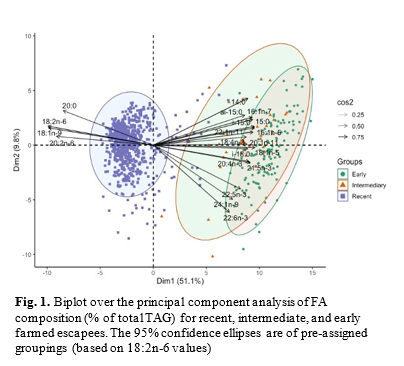DIET- AND ESCAPE-HISTORY AMONG FARMED ATLANTIC SALMON Salmo salar ESCAPEES CAUGHT IN NORWEGIAN RIVERS AND ON THE COAST IN THE PERIOD 2011-2021
Each year, thousands of farmed Atlantic salmon (Salmo salar) escape from net pens in Norway. Although the majority don’t survive until maturation, some escapees enter rivers where they may interbreed wild salmon. Farmed salmon display reduced spawning success in the wild, but how long the escapees have been on the run is likely of importance for their reproductive success. Due to their more natural life cycle, farmed salmon that escape early in the production cycle (early escapees) and survive to maturation could be better competitors and consequently contribute more to introgression than mature farmed salmon that have recently escaped (recent escapees). However, knowledge about time-since-escape of farmed salmon approaching the spawning grounds, and the variation in escape history in time and space, is limited.
Shortly after escaping, farmed escapees have a fatty acid (FA) profile which reflects the aquaculture feed. However, early escapees, which likely escaped as smolt, will, as adults, have the same FA profile as wild salmon. Thus, the terrestrial FA 18:2n-6 can be used as a marker for the aquaculture diet and separate the escapees based on time-since-escape (Fig. 1). Little is known about farmed escapees’ long term diet post-escape. Using FA profiling, we are able to not only separate the farmed salmon by time-since-escape but also examine the diet of escapees and wild salmon to investigate whether the diet is the same for the escapees which successfully made the switch to marine feed. In addition, two genes (vgll3 and six6) that are hypothesized to be linked to diet were examined and connected to the individual’s FA profile to determine whether hese genetic markers
The overall aim of this project was to investigate the escape history and compare the diet of escaped salmon to wild salmon. This was achieved by distinguishing escapees from wild individuals using scales, fatty acids both as biomarkers and time-since-escape assignment, and genotyping of salmon caught in four rivers and marine fisheries in Norway from 2011 to 2021.
